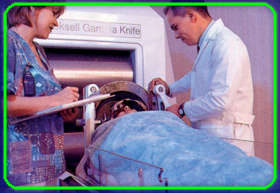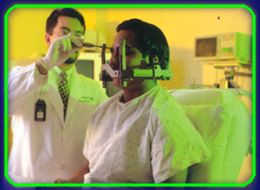|
 Who
can be treated with Gamma Knife? Who
can be treated with Gamma Knife?
The patients with
brain tumoral lesions located in critical areas, or which are of difficult
access, and are not larger than 3,5 cm diameter; patients with arterovenous
malformations whose location transforms the microsurgical performance
into a risky procedure; patients who, due to an advanced age or medical
concomitant ailments, have surgical interventions proscribed; as a surgery
coadjutant in partial tumor recessions; in functional surgery to treat
the trigeminal neuralgia, and patients with malignant metatastic brain
tumors.
Indications are
expanding every day, since new treatment and research protocols open
new therapeutic horizons.
Arteriovenous
Malformations
Several
studies indicate that radiosurgery with gamma-ray bistoury has a high
clinical efficience, and a significative reduction of morbility can
be achieved, when compared with microsurgery treating the arterovenous
malformations.
This technique is
used in patients with small and medium-sized arterovenous malformations
at all brain locations. But it probably has a more important roll handling
arterovenous malformations located in critical areas of the brain.
The objective of radiosurgery is achieving a complete closing of the
vascular network with progressive thickening of the vascular walls until
the lumen becomes occluded. A latency period of 1 to 3 years is usually
necessary before the total closing occurs.
It is a non-invasive and effective method to treat arteriovenous malformations
of levels I, II, and III, according to Martin-Spetzler's scale.
Acoustic
Neurinomata
The objective
of radiosurgery when treating the acoustic neurinomata is obtaining
the tumoral control, and the preservation of the cranial pairs' functions.
Realized studies
show that the percentage of tumoral control is higger than 94%, with
a high preservation of the auditive, facial, and trigeminal functions.
Tumoral control means stabilizing or reducing the size of tumor after
the treatment.
 Meningiomata Meningiomata
The
stereotactic radiosurgery using the gamma-ray bistoury is excellent
for the primary or complementary treatment of meningiomata located at
the intracerebral areas of difficult access.
Stereotactic radiosurgery
is applied with an extraordinary precision for the intracranial meningiomata,
since these tumors are usually very well demarcated and they rarely
attack the brain.
It is associated with a high percentage of long-term tumoral control,
and an important reduction of the surgical risks. The tumoral cotrol
of meningiomata is higher than 95%.
Cerebral
Metastasis
Excellent
results have been issued in relation to the reduction or disparition
of metastatic tumors as a result of using the gamma-ray bistoury, even
in those tumors tradiotionally regarded as radioresistant.
Radiosurgery provides a tumoral control percentage exceeding 89%.
Pituitary
Tumors
For those
patients who do not require a decompression of the optical apparatus,
stereotactic radiosurgery using Gamma Knife represents an effective
option.
It has a great application as a coadjutant therapy for small, residual,
or recurrent pituitary adenomata after the microsurgery.
Gliomata
Radiosurgery
has been used to handle in a multidisciplinary way those patients suffering
from gliomatic tumoral lesions. It is an alternative method providing
a dose of local radiation reinforcement.
Radiosurgery is used
for those patients with malignant gliomatic tumors of a diameter smaller
than 4,0 cm, together with other treatment modalities, such as chemiotherapy
and fractional radiotherapy.
Tumors
at the base of the cranium
Neurosurgery
with the gama-ray bistoury is the best of the minimally-invasive sugery
techniques. In the case of tumors at the base of the cranium reaches
a high percentage of tumoral control, with a high preservation of the
involved healthy structures' function; this is due to the perfect delimitation
of the tumoral lesion, the respect of the healthy adjacent zones, and
the non-invasivity.
Such tumors include
malignant ones from the cranial base, invasive ones down from the neck,
such as the nasopharyngeal carcinomata, and other adenocarcinomata or
scaly cell carcinomata from the pharynx or the salivary glands, chordomata,
chondrosarcomata, etc.
Trigeminal
Neuralgy
The gamma-ray
bistoury has a successful application treating the typical painful tic,
obtaining an important pain-freeing and few damage of the facial sensibility.
In cases of trigeminal
neuralgia resistant to medical or surgical treatment, and in the cases
of aged patients or suffering from medical problems, radiosurgery with
Gamma Knife has an extraordinary value.
 We invite you to watch the procedure in a
more detailed way. (
We recommend you installing the Flash 3 plug-in or higher into your
navigator)
We invite you to watch the procedure in a
more detailed way. (
We recommend you installing the Flash 3 plug-in or higher into your
navigator)

|
 Who
can be treated with Gamma Knife?
Who
can be treated with Gamma Knife? Meningiomata
Meningiomata